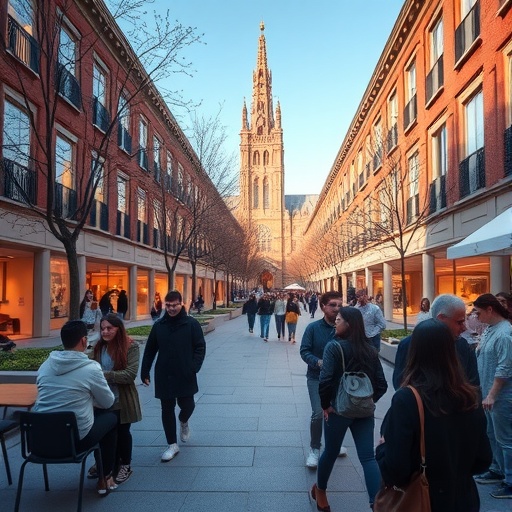The significance of belonging in public spaces within higher education is a topic that transcends cultural boundaries and affects student engagement, retention, and overall wellbeing. In recent discourse, the study conducted by Bart-Plange, Henderson, and Hoffman sheds light on how these public spaces can be inclusive and supportive, while also revealing inherent biases and challenges faced by various student demographics. This critical analysis serves as a roadmap for institutions striving to foster environments where every student feels a sense of connection and purpose.
In higher education settings, public spaces are often the epicenter of student life. These areas, ranging from libraries and cafeterias to lounges and outdoor plazas, serve not only as physical locales for interaction but also as symbols of institutional identity. The authors argue that how these spaces are designed, maintained, and utilized can significantly impact student belonging. By examining case studies and empirical evidence, they illustrate that a sense of belonging is closely linked to institutional success, as it influences students’ academic achievement, social integration, and emotional health.
Critiquing existing practices, the study highlights several key factors that contribute to a lack of belonging in public spaces. One crucial observation is that many educational institutions inadvertently reinforce social hierarchies through the design of their public spaces. For instance, spaces that prioritize aesthetics over functionality may exclude individuals who need accessible routes or sensory-friendly environments. The authors call for a re-examination of how these spaces are conceived to ensure they promote inclusivity rather than exclusion.
Moreover, the authors point out that cultural representations within public spaces play a pivotal role in shaping students’ perceptions of belonging. When students see themselves reflected in the artwork, signage, and decor of these spaces, it can foster a sense of recognition and acceptance. Conversely, when cultural diversity is overlooked, it can alienate significant segments of the student population. This observation underlines the need for institutions to engage in ongoing dialogue with students about their experiences and needs regarding campus spaces.
The authors’ analysis also explores the psychological aspects of belonging, emphasizing that the feeling of being an integral part of a community is vital for personal and academic growth. In their research, they found that students who reported a strong sense of belonging were more likely to participate actively in campus life and seek out leadership opportunities. This connection suggests that institutions must prioritize belonging among their core values to stimulate student engagement and satisfaction.
Additionally, the study reveals how the intersectionality of identities affects students’ experiences in public spaces. Factors such as race, gender, and socioeconomic status can significantly influence how a student perceives and interacts with their environment. For instance, students from marginalized backgrounds may experience barriers to engagement in these spaces, creating a sense of isolation rather than community. The research urges institutions to adopt a nuanced understanding of belonging that considers diverse student backgrounds and experiences.
The findings of this study also resonate with the broader trends observed in higher education during the last decade. There has been a growing emphasis on mental health and well-being on campuses, with many institutions acknowledging that nurturing a sense of belonging can mitigate feelings of loneliness and anxiety. In this context, public spaces can serve as therapeutic environments, fostering social interactions that contribute positively to students’ psychological health.
The analysis conducted by Bart-Plange et al. does not merely critique existing constructs of belonging; it also proposes innovative solutions that institutions can implement. For example, they suggest co-designing public spaces with students to incorporate their insights and preferences actively. This collaborative approach can lead to more empathetic designs that reflect the diverse needs of the student body and enhance the overall college experience.
Moreover, the authors emphasize the importance of ongoing assessment and adaptation of public spaces in higher education. As student demographics evolve, institutions must remain agile in their approach to creating inclusive environments. Gathering data on student satisfaction with public spaces can inform modifications and improvements, ensuring these areas remain relevant and responsive to the changing needs of the community.
The dialogue around belonging in public spaces also extends to the roles of faculty and institutional leadership. By actively participating in creating welcoming environments, educators can model inclusive behaviors and encourage students to engage in meaningful interactions. Faculty members play a vital role in shaping campus culture, and their support can significantly enhance students’ feelings of belonging.
In summary, the research by Bart-Plange, Henderson, and Hoffman calls for a critical and transformative reimagining of public spaces in higher education. Their work not only critiques the status quo but also provides actionable insights that institutions can utilize to foster belonging. By prioritizing inclusivity, understanding diverse student needs, and actively engaging with students in the design process, higher education institutions can create environments that truly resonate with all members of their communities.
Ultimately, the journey toward belonging in public spaces is not merely an institutional responsibility but a collective one that involves students, educators, and policymakers. As higher education continues to evolve in response to societal changes, the understanding and implementation of belonging must evolve as well. This ongoing dialogue will be crucial in shaping the future of public spaces, transforming them into transformative environments that support every student’s journey.
Subject of Research: Belonging in Public Spaces in Higher Education
Article Title: Critiquing and Reimagining Belonging in Public Spaces in Higher Education
Article References:
Bart-Plange, DJ., Henderson, K., Hoffman, K. et al. Critiquing and Reimagining Belonging in Public Spaces in Higher Education.
Educ Psychol Rev 37, 87 (2025). https://doi.org/10.1007/s10648-025-10061-z
Image Credits: AI Generated
DOI: 10.1007/s10648-025-10061-z
Keywords: belonging, public spaces, higher education, inclusivity, student engagement, institutional culture, equity, design, community, mental health, diversity, student experience, collaboration, assessment




